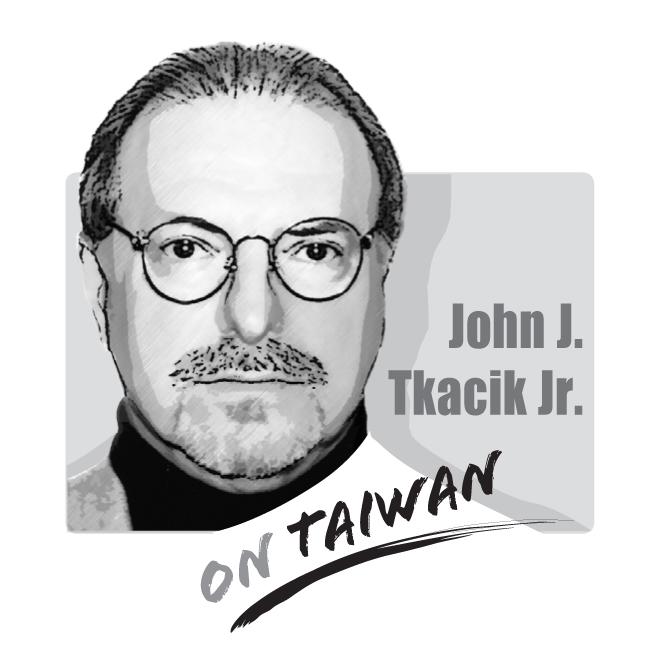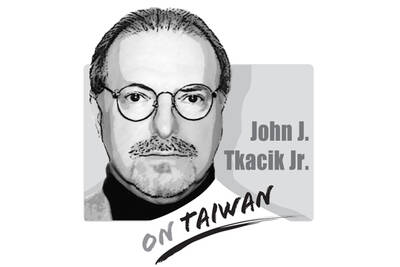I am just getting around to reading Dr. Chang Hsien-yi’s (張憲義) oral history published in 2016 entitled Nuclear Bomb! Spy? CIA (核彈! 間諜? CIA). Dr. Chang’s defection to the Central Intelligence Agency 33 years ago is one of the reasons that Taiwan does not have a nuclear deterrent today in the face of yet another Formosa Strait Crisis, and from his book, I can see that Dr. Chang still has strong views on the subject.
In the Second Formosa Strait Crisis from August to October 1958, the United States deflected Sino-Soviet aggression against the offshore islands of Quemoy (金門) and Matsu (馬祖) with the deft display of atomic weapons systems, in Taiwan and in supporting bases on Okinawa and the Philippines. Earlier that year, President Eisenhower deployed 20 Matador (鬥牛士飛彈) TM-61 nuclear cruise missiles to Tainan Airbase as tensions in the Formosa Strait smoldered, and a declassified mission list for the Tainan missiles reads: “Offense (atomic).”
In August 1958, as previously abandoned Chinese airfields on the Fujian coast began to fill up with hundreds of new Soviet-built jet fighters, President Eisenhower authorized the emergency transfers of F-86, F-100 and F-104 fighters together with “Sidewinder” missiles to the ROC Air Force. When the crisis peaked on August 23-24, 40,000 heavy artillery rounds erupted each day atop Quemoy’s fortifications, US air and naval forces were already in position, and 61 USAF fighters deployed to air bases in Taiwan augmented some 500 ROC Air Force jets. Communist Chinese fighter fleets over the Strait were decimated, losing 35 MiG-17s to 4 ROC F-84s and F-86s lost. Taiwan’s aircraft ruled the skies.

Although the Commander of the US Pacific Air Forces recommended the immediate use of atomic weapons against Chinese artillery positions in Xiamen, President Eisenhower ordered that nuclear weapons be used only as a last resort; and only with his explicit permission. On October 22, 1958, Secretary of State Dulles arrived in Taipei to personally brief President Chiang Kai-shek (蔣介石) on atomic weapons’ use against PLA artillery in Xiamen. “Only nuclear guns could do that job effectively,” Dulles explained. President Chiang asked if small “tactical atomic weapons might be advisable,” but Dulles explained that no tactical scale weapons could neutralize the concrete fortifications, only those with the “power of the Hiroshima or Nagasaki bombs” could be effective. Such weapons, however, “would kill millions” and “there would be a heavy fissionable fall-out if bombs exploded in or near the ground.” Dulles said, “if the bombs exploded in the air, they would have no effect on the gun positions.” With this, President Chiang suggested that “the problem be left for further study.” After Dulles’s meeting, he tasked the US ambassador to “arrange for an authoritative military briefing on the subject for Chiang.”
Only in 1960 did the United States first base nuclear warheads on Taiwan; by 1970, about 200 nuclear weapons under US sovereign control were in place on Taiwan. President Nixon began to draw down the US nuclear force in Taiwan in 1972, the last ones in 1974.
Unfortunately, the removal of US nuclear weapons did nothing to end the nuclear threat to Taiwan. In 1996, as Taiwan prepared for its first democratic presidential elections, there came a new sense of urgency in Beijing to end Taiwan’s quest for “independent international status.” PLA general Xiong Guangkai (熊光楷) predicted missile attacks on Taiwan and asserted that China could act militarily against Taiwan without fear because American leaders “care more about Los Angeles than they do about Taiwan,” a threat by China to use nuclear weapons against the US. When China’s “missile tests” landed in waters near Taiwan’s largest seaports, President Clinton responded by dispatching two aircraft carrier battle groups to the Strait region. Tensions eased for a time.
In 2005, following China’s “Anti-Secession Law,” PLA general Zhu Chenghu (朱成虎) explained China’s “no first-use” nuclear weapons policy actually meant quite the opposite: “If the Americans draw their missiles and position-guided ammunition into the target zone on China’s territory, I think we will have to respond with nuclear weapons,” and “if the Americans are determined to interfere ... we will be determined to respond, and we Chinese will prepare ourselves for the destruction of all cities east of Xi’an (西安), of course the Americans will have to be prepared that hundreds of, or two hundreds or even more cities will be destroyed by the Chinese.”
Fifteen years have gone by since General Zhu’s off-handed threat of nuclear Armageddon. General Zhu is still featured on China’s National Defense University faculty website. China’s Army has expended vast financial and scientific resources to assemble a new nuclear arsenal with a wide range of destructive yields and technologically advanced delivery systems. In the Formosa Strait, Chinese naval and air forces have increased the pace and number of incursions into Taiwan’s air defense zone, and the Trump Administration duly responded with increased US naval and air operations in the South China Sea and the Formosa Strait.
Last week, an American think tank published satellite imagery of at least 16 new nuclear missile silos and training areas in Inner Mongolia for the Chinese Rocket Force’s new DF-41 (東風-41) intercontinental ballistic missile. Each DF-41 is designed to deliver multiple reentry warheads — my colleague Richard Fisher suggests each DF-41 carries eight separate warheads, the silos represent 124 new warheads.
Last month, Admiral Charles Richard, commander of the US Strategic Command, wrote, “There is a real possibility that a regional crisis with Russia or China could escalate quickly to a conflict involving nuclear weapons, if they perceived a conventional loss would threaten the regime or state.” Both nations have flexible arrays of nuclear devices, down to weapons of sub-kiloton range, weapons whose existence is designed for battlefield use, not strategic deterrence. Admiral Richard implored the Pentagon to abandon its principal assumption that nuclear weapons’ use is nearly impossible and accept the fact that “nuclear employment is a very real possibility.”
The Admiral also magnified the Pentagon’s September 2020 assessment that “China’s nuclear weapons stockpile is expected to double over the next decade…” adding, “…if not triple or quadruple.” A Chinese nuclear arsenal four times the current force would put it in the same magnitude as America’s and Russia’s.
So, in light of its tremendous destructive power, is nuclear deterrence still relevant?
Many nations think so. In 2021, the deterrent value of a nuclear force is embraced by China’s closest client states, North Korea and Iran. China encourages both.
Against this backdrop of hyper-advanced nuclear destruction, how can Taiwan hope to preserve its international status? Taiwan’s current “unsettled” legal status has been the foundation of Taiwan’s separate existence, but unless the United States, Japan, Australia and like-minded democracies are willing to face down China’s new “usable” nuclear force, can they preserve Taiwan?
In 1988, the year of Chang Hsien-yi’s defection, North Korea embarked upon a clandestine nuclear weapons program that 30 years later flowered into a credible and technologically modern nuclear force in 2017. Iran is now developing its own weapons grade fissile material.
What if the United States had adopted China’s and Russia’s attitude toward Iran and North Korea and allowed allied states to acquire nuclear deterrents? How would Taiwan have fared these past 33 years since Dr. Chang Hsien-yi’s defection if Taiwan’s nuclear weapons program had been allowed to succeed? Might the world now be — paradoxically — more secure if South Korea, Japan and Taiwan had their own independent nuclear forces?
Dr. Chang Hsien-yi warns, “If the person in office has any consideration for his nation’s survival, he certainly must possess a bargaining chip that demonstrates intimidating force to any foreign power, otherwise he will have no say in the arena of international Realpolitik; or even if he does have a say, it will be a mere trifle.” In 1988, Dr. Chang trusted the United States to defend Taiwan from a nuclear strike. In the new Formosa Strait Crisis, what bargaining chip does Taiwan have left that can intimidate a predator?
[Note: In May 1959, my father, a US Army engineer, with his wife and six children disembarked from a US naval ship at the port of Keelung. I was only ten years old. Before we left America, my worldly-wise older cousin told me about President Eisenhower’s “Formosa Doctrine” and the “Formosa Strait Crisis” and impishly joked that on the Island of Formosa I would play “dodge shells” (躲避炮彈) like playing “dodgeball”. It was a reference that puzzled me at the time, but I quickly came to understand. Our family lived on Grass Mountain (草山) high above old Tienmu (天母) where the Chinese Cultural University is today, on a ridgeline defended by three anti-aircraft guns, their sandbag revetments crowned with small metal silhouettes of Chinese fighter jets. In June 1960, I stood on the wall of the US military compound Chung-Shan North Road and waved to President Eisenhower and President Chiang as their motorcade sailed through an ocean of cheering Taiwanese flag-wavers. “This must be important,” I thought, “President Eisenhower is here”. So, I call this the “Formosa” Strait Crisis to lend a sense of historical continuity to the current crisis. — jjt]
John J. Tkacik, Jr. is a retired US foreign service officer who has served in Taipei and Beijing and is now director of the Future Asia Project at the International Assessment and Strategy Center.
A Chinese diplomat’s violent threat against Japanese Prime Minister Sanae Takaichi following her remarks on defending Taiwan marks a dangerous escalation in East Asian tensions, revealing Beijing’s growing intolerance for dissent and the fragility of regional diplomacy. Chinese Consul General in Osaka Xue Jian (薛劍) on Saturday posted a chilling message on X: “the dirty neck that sticks itself in must be cut off,” in reference to Takaichi’s remark to Japanese lawmakers that an attack on Taiwan could threaten Japan’s survival. The post, which was later deleted, was not an isolated outburst. Xue has also amplified other incendiary messages, including one suggesting
Chinese Consul General in Osaka Xue Jian (薛劍) on Saturday last week shared a news article on social media about Japanese Prime Minister Sanae Takaichi’s remarks on Taiwan, adding that “the dirty neck that sticks itself in must be cut off.” The previous day in the Japanese House of Representatives, Takaichi said that a Chinese attack on Taiwan could constitute “a situation threatening Japan’s survival,” a reference to a legal legal term introduced in 2015 that allows the prime minister to deploy the Japan Self-Defense Forces. The violent nature of Xue’s comments is notable in that it came from a diplomat,
Before 1945, the most widely spoken language in Taiwan was Tai-gi (also known as Taiwanese, Taiwanese Hokkien or Hoklo). However, due to almost a century of language repression policies, many Taiwanese believe that Tai-gi is at risk of disappearing. To understand this crisis, I interviewed academics and activists about Taiwan’s history of language repression, the major challenges of revitalizing Tai-gi and their policy recommendations. Although Taiwanese were pressured to speak Japanese when Taiwan became a Japanese colony in 1895, most managed to keep their heritage languages alive in their homes. However, starting in 1949, when the Chinese Nationalist Party (KMT) enacted martial law

“Si ambulat loquitur tetrissitatque sicut anas, anas est” is, in customary international law, the three-part test of anatine ambulation, articulation and tetrissitation. And it is essential to Taiwan’s existence. Apocryphally, it can be traced as far back as Suetonius (蘇埃托尼烏斯) in late first-century Rome. Alas, Suetonius was only talking about ducks (anas). But this self-evident principle was codified as a four-part test at the Montevideo Convention in 1934, to which the United States is a party. Article One: “The state as a person of international law should possess the following qualifications: a) a permanent population; b) a defined territory; c) government;